New Fossils Resolve Whale's Origin
Ben Harder
Recent fossil finds from Pakistan overturn the
picture of whale evolution long championed by
paleontologists, bringing them closer to agreement with
an alternative view proposed by molecular biologists.
The discoveries establish a close evolutionary link
between cetaceans, which include whales, dolphins, and
porpoises, and a group of mammals known as artiodactyls.
These hoofed animals with an even number of toes include
cows, sheep, goats, pigs, deer, and hippopotamuses.
 |
|
Approximately 50 million years
ago, this wolf-size pakicetid—an ancestor of the
whale—lived on land but may have waded into
streams to feed on fish.
C.
Buell/NEOUCOM |
Four-legged, terrestrial ancestors of whales and
other cetaceans waded into the sea about 55 million
years ago and gradually developed skeletal adaptations
for aquatic life, paleontologists hold. But precisely
what variety of land mammal first got its feet wet has
been a source of spirited debate (SN: 11/6/99, p. 296).
"We've thought since the ' 60s that whales evolved
from hoofed, carnivorous mammals" known as mesonychians,
says Philip D. Gingerich of the University of Michigan
in Ann Arbor. Like most paleontologists, he says, he
"considered it pretty well established" on the basis of
dental similarities that cetaceans were surviving
descendants or close relatives of this otherwise extinct
group.
However, Gingerich's latest report, in the Sept. 21
Science, removes whales from the mesonychians and
places them in the same evolutionary lineage as
artiodactyls—just as researchers analyzing genetic and
immunological data have maintained.
Gingerich and his colleagues reversed their position
after analyzing the skeletons of two early aquatic
whales, about the size of sea lions, that they unearthed
last year in central Pakistan. The fossils, which they
gave species names of Artiocetus clavis and
Rodhocetus balochistanensis, are the first of
cetaceans ever discovered with intact ankle bones.
 |
|
An artist's rendering of a
largely aquatic early whale of the genus
Rodhocetus. This mammal lived near the
shores of the Tethys Sea, between Asia and the
South Asian subcontinent, about 47 million years
ago.
J.
Klausmeyer/Science |
To the researchers' surprise, the ankle had a unique
form that's found only in artiodactyls. Since living
cetaceans have no vestige of these bones, the discovery
of early whales with distinctly artiodactyl ankles
provides a "Rosetta stone" linking modern marine mammals
to living artiodactyls, says Gingerich.
"The new [fossil] data are much more in agreement
with the molecular data than what we thought before,"
says J.G.M. Thewissen, a paleontologist at the
Northeastern Ohio Universities College of Medicine in
Rootstown. Working independently in fossil beds in
northern Pakistan, he and his colleagues have concluded
that pakicetids, a group ancestral to modern cetaceans
and predating the transition to marine life, also had
the artiodactyl ankle form. They report their work in
the Sept. 20 Nature.
The new finds are "very exciting for those of us
working on molecular data," says John Gatesy, an
evolutionary biologist at the University of California,
Riverside, whose work in nuclear DNA sequencing supports
a close whale-artiodactyl relationship.
Gatesy's data and other lines of molecular evidence
also suggest that whales have a closer evolutionary
relationship with hippos than with other artiodactyls.
Paleontologists, however, aren't ready to group whales
with any specific artiodactyl.
"None of the fossil evidence supports hippos and
whales as being sister taxa," says Kenneth D. Rose, a
paleontologist at the Johns Hopkins Medical Institutions
in Baltimore.
Nevertheless, Gingerich predicts that renewed focus
on the fossil record of early artiodactyls will help
researchers determine just where the whales fit in. And
that, he acknowledges, could be alongside the hippos.

References:
Gingerich, P.D., et al. 2001.
Origin of whales from early artiodactyls: Hands and feet
of Eocene Protocetidae from Pakistan. Science
293(Sept. 21):2239.
Thewissen, J.G.M., et al.
2001. Skeletons of terrestrial cetaceans and the
relationship of whales to artiodactyls. Nature
413(Sept. 20):277.
Further Readings:
Monastersky, R. 1999. The whale's
tale. Science News 156(Nov. 6):196.
______. 1998. Fossil jaw tells tale
of whale evolution. Science News 154(Oct.
10):229. Available at http://www.sciencenews.org/sn_arc98/10_10_98/Fob3.htm.
Additional information can be found
at Dr. Thewissen's Web site: http://www.neoucom.edu/Depts/Anat/Pakicetidnew.html.
Sources:
John Gatesy
Department of
Biology
University of California,
Riverside
Riverside, CA 92521
Philip D. Gingerich
Department of
Geological Sciences
Museum of
Paleontology
University of Michigan, Ann Arbor
Ann
Arbor, MI 48109-1079
J.G.M. "Hans" Thewissen
Department
of Anatomy
Northeast Ohio Universities College of
Medicine
Rootstown, OH 44272
Kenneth D. Rose
Program for
Functional Anatomy and Evolution
Johns Hopkins
Medical Institutions
Baltimore, MD 21205
|